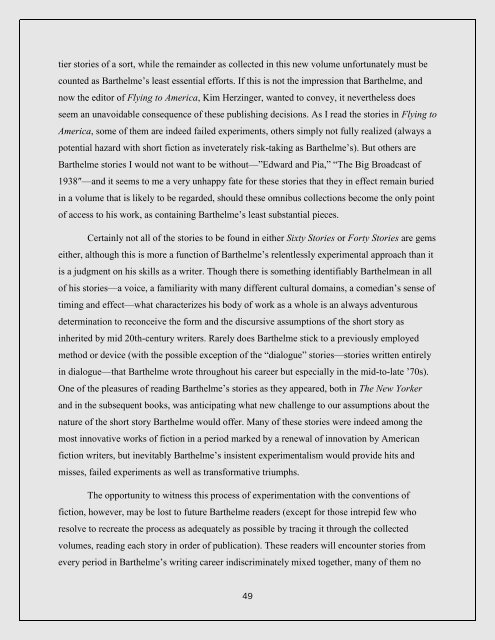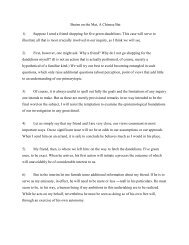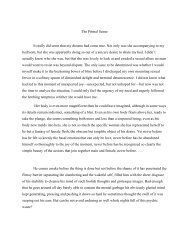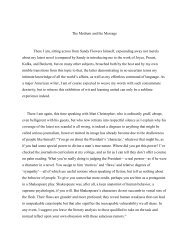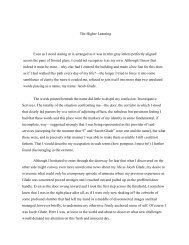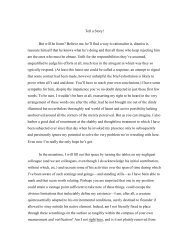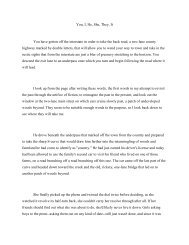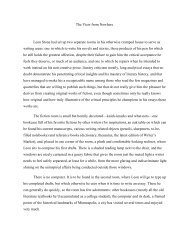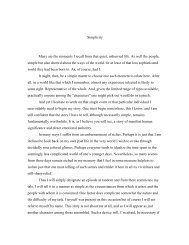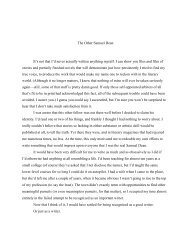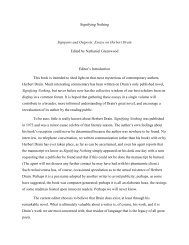APF
Create successful ePaper yourself
Turn your PDF publications into a flip-book with our unique Google optimized e-Paper software.
tier stories of a sort, while the remainder as collected in this new volume unfortunately must be<br />
counted as Barthelme’s least essential efforts. If this is not the impression that Barthelme, and<br />
now the editor of Flying to America, Kim Herzinger, wanted to convey, it nevertheless does<br />
seem an unavoidable consequence of these publishing decisions. As I read the stories in Flying to<br />
America, some of them are indeed failed experiments, others simply not fully realized (always a<br />
potential hazard with short fiction as inveterately risk-taking as Barthelme’s). But others are<br />
Barthelme stories I would not want to be without—”Edward and Pia,” “The Big Broadcast of<br />
1938″—and it seems to me a very unhappy fate for these stories that they in effect remain buried<br />
in a volume that is likely to be regarded, should these omnibus collections become the only point<br />
of access to his work, as containing Barthelme’s least substantial pieces.<br />
Certainly not all of the stories to be found in either Sixty Stories or Forty Stories are gems<br />
either, although this is more a function of Barthelme’s relentlessly experimental approach than it<br />
is a judgment on his skills as a writer. Though there is something identifiably Barthelmean in all<br />
of his stories—a voice, a familiarity with many different cultural domains, a comedian’s sense of<br />
timing and effect—what characterizes his body of work as a whole is an always adventurous<br />
determination to reconceive the form and the discursive assumptions of the short story as<br />
inherited by mid 20th-century writers. Rarely does Barthelme stick to a previously employed<br />
method or device (with the possible exception of the “dialogue” stories—stories written entirely<br />
in dialogue—that Barthelme wrote throughout his career but especially in the mid-to-late ’70s).<br />
One of the pleasures of reading Barthelme’s stories as they appeared, both in The New Yorker<br />
and in the subsequent books, was anticipating what new challenge to our assumptions about the<br />
nature of the short story Barthelme would offer. Many of these stories were indeed among the<br />
most innovative works of fiction in a period marked by a renewal of innovation by American<br />
fiction writers, but inevitably Barthelme’s insistent experimentalism would provide hits and<br />
misses, failed experiments as well as transformative triumphs.<br />
The opportunity to witness this process of experimentation with the conventions of<br />
fiction, however, may be lost to future Barthelme readers (except for those intrepid few who<br />
resolve to recreate the process as adequately as possible by tracing it through the collected<br />
volumes, reading each story in order of publication). These readers will encounter stories from<br />
every period in Barthelme’s writing career indiscriminately mixed together, many of them no<br />
49


